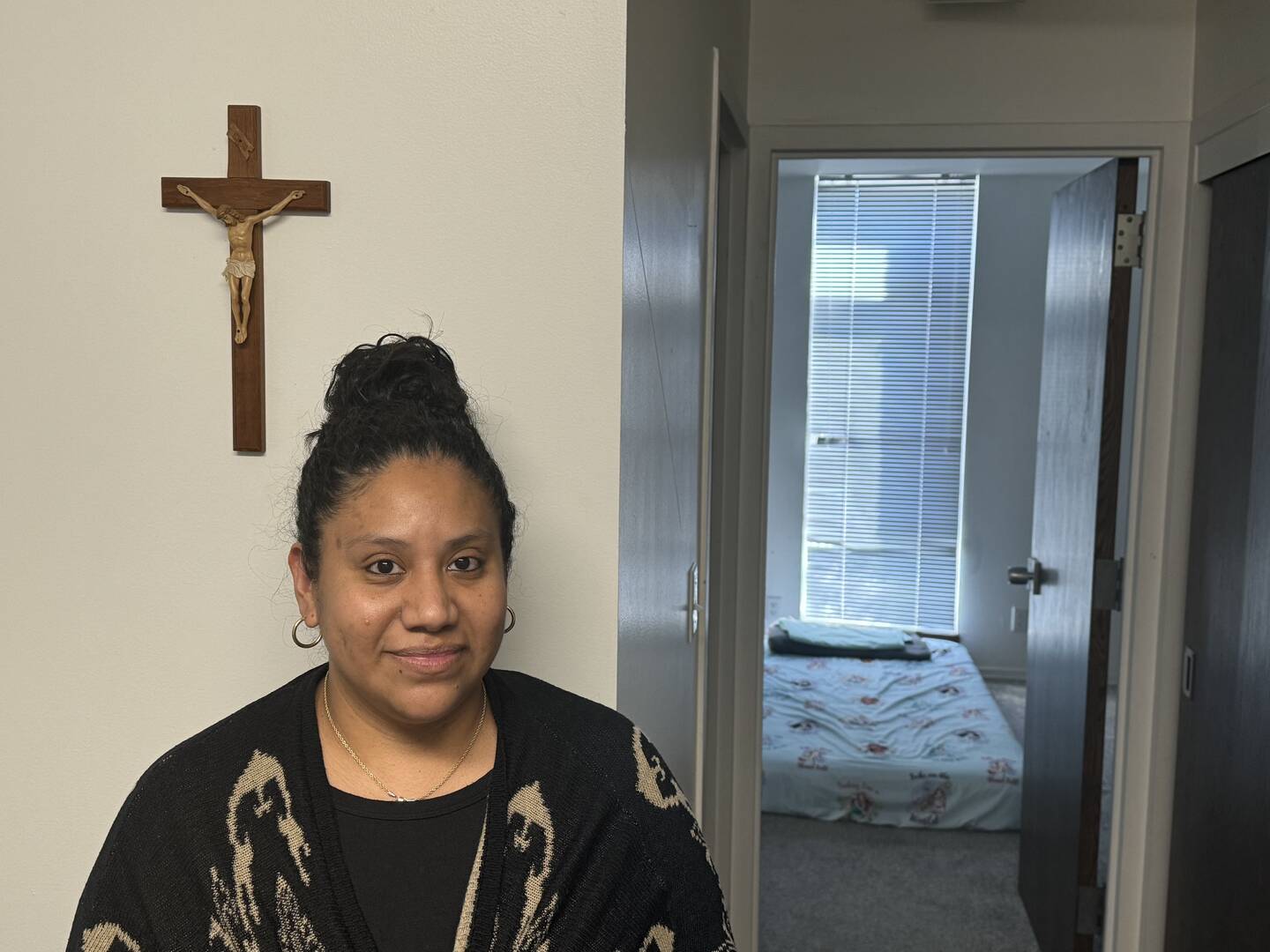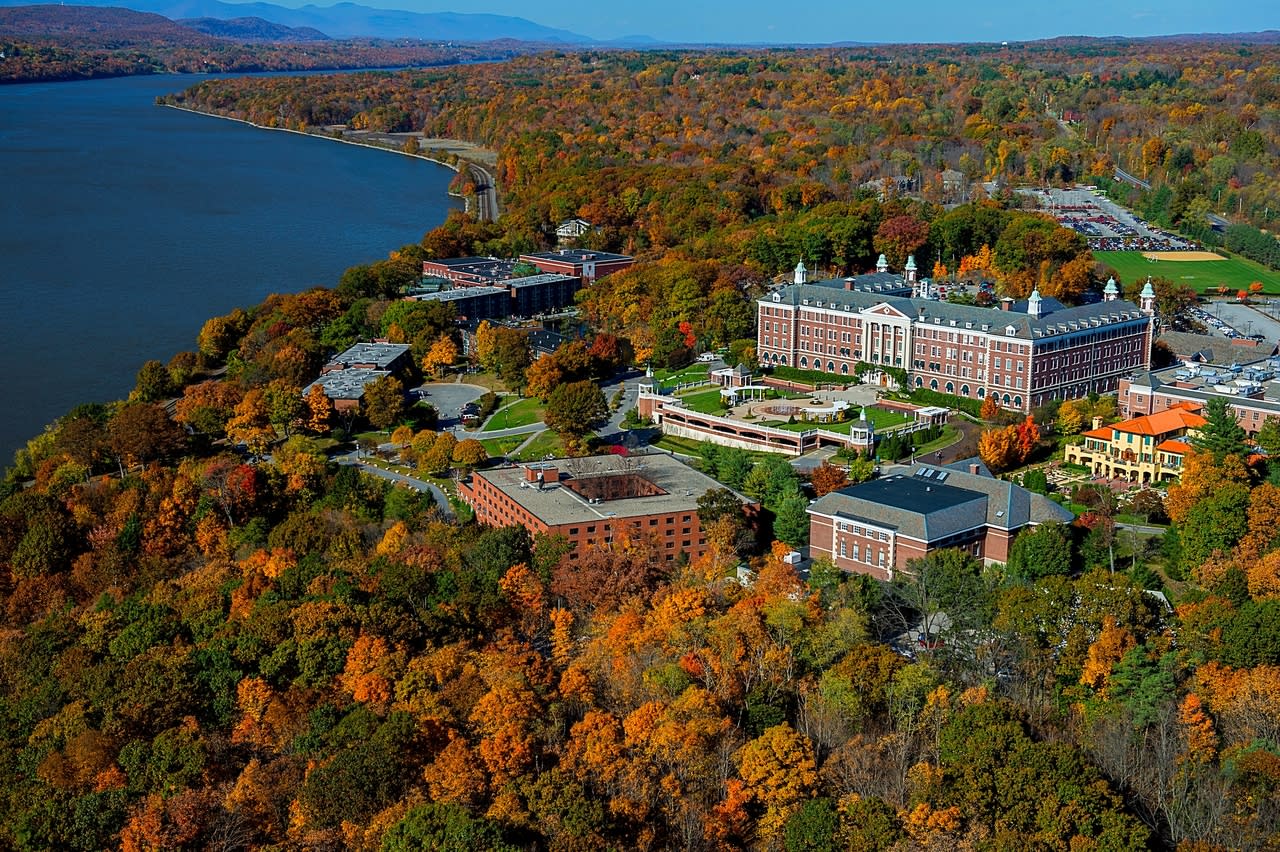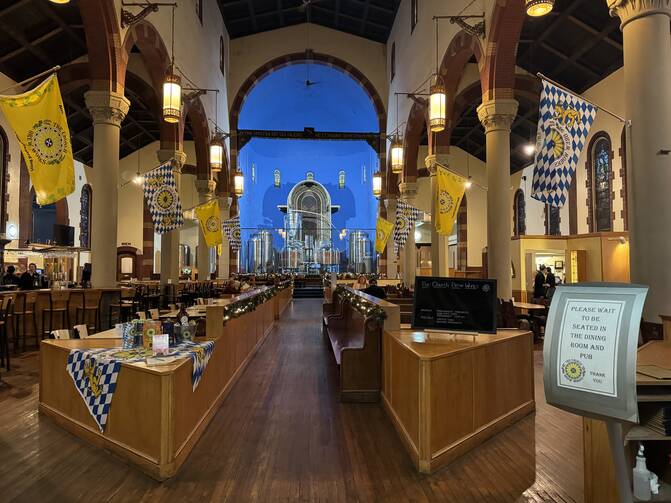Inside the former St. Elizabeth’s Slovak Catholic Church in downtown Pittsburgh, the evangelical pastor in pressed blue jeans appears 12 feet tall on a movie screen. Young adult worshipers take notes on his sermon and glance at open Bibles. Inaugurated in 1908 and sold by the Diocese of Pittsburgh two decades ago, the red brick church now belongs to Orchard Hill, a suburban evangelical church. “These walls have seen so much,” says Dan Irvin, pastor of Orchard Hill’s downtown campus.
On the other side of Pittsburgh that day, Monique Herrera helps an asylum seeker from Nicaragua and her 2-year-old son prepare for their Sunday in a rectory converted into a halfway house for refugees. The rectory closed last year, and St. Joseph the Worker Parish, in a move approved by the diocese, now offers free use of the building to Casa San Jose, a Pittsburgh group that helps immigrants.
Because of shrinking numbers in the pews and fewer vocations to the priesthood, the Catholic Church, the largest private real estate owner in the world, faces decisions about what to do with its extensive real estate portfolio. Particularly in the Northeast and Midwest, where more parishes are closing or merging than in other parts of the country, the church has a chance to transform the way it serves urban neighborhoods. The two buildings I visited in Pittsburgh—two of the thousands of churches, schools, rectories and convents across the United States that the Catholic Church and other religious institutions have closed in recent years—show how wildly different the outcomes can be.
The Catholic Church, the largest private real estate owner in the world, faces decisions about what to do with its extensive real estate portfolio.
We are now in the second generation of converted church buildings. Starting in the last few decades of the 20th century, dioceses facing declining church attendance sold off church real estate; some ended up as brewpubs, art galleries, condos, bookstores or museums. Now, in the third decade of the 21st century, advocates inside and outside the church are spearheading a more intentional approach to repurposing church buildings.
In 2018, the Vatican hosted an international conference titled “Doesn’t God Dwell Here Anymore?” and published guidelines for dioceses looking to sell church property. They included the prohibition against selling sacred relics and turning over buildings to “sordid” use, such as liquor stores, abortion clinics and nightclubs, and a reminder to destroy altars when a church ceases to be a church. In a letter to the conference, Pope Francis reminded delegates of the model given by St. Lawrence, a third-century deacon who is remembered for “selling the precious items of worship and distributing the proceeds to the poor.”
In practice, canon law gives dioceses around the world a great deal of freedom, specifying only that bishops can relegate buildings to “profane but not sordid use.” That freedom has invited research and debate, and, a few years ago, the University of Notre Dame launched the Church Properties Initiative, which among other things tracks adaptations of church properties into shelters, community centers, art spaces and other uses.
“The church has a public vocation,” says the program manager, Madeline G. Johnson. “It’s not a private club.”
The reuse of church buildings “is an opportunity for the church to reimagine its relationship to the market and itself,” says Ms. Johnson, who wrote a master’s thesis about churches in Montreal renting out their spaces at below-market rates to socially conscious organizations such as a Polish cultural center, a music co-op and a public relations firm that helps nonprofits.
From Temples to Churches
Whether you are a believer or not, there is still something special about churches. They are free to enter. They are an invitation to contemplate the transcendent. They are community centers, where people gather to celebrate the miraculous and sacramental, like births, love and death.
The first churches were converted temples in ancient Rome, and these churches “differed from traditional Roman temples by the mere fact that the people were in the building,” says Christopher Denny, a theologian at St. John’s University in New York. “The preferred model for Greek and Roman temples was a statue of the virgin goddess, and a lot of priests, and ordinary people were outside the building.”
In medieval Europe, towns dedicated centuries to erecting cathedrals and chiseling, carving and sculpting them to perfection. Masons would move to a town and begin work on a cathedral that their sons and grandsons would finish. Once built, the cathedral appeared invulnerable to the ravages of time. Secular authorities in Europe, who have often subsidized the church, often moved to preserve buildings even as church attendance dwindled. “In Europe, governments feel a responsibility to maintain churches,” says Daniel Rober, a theologian at Sacred Heart University in Fairfield, Conn. Witness the French government’s management of the renovation of Notre-Dame de Paris.
When Catholics from Ireland, Italy, Germany and other European nations migrated to U.S. cities in the 19th and 20th centuries, they built churches that served as community centers, where millions were baptized, married and honored at funerals. When their children and grandchildren migrated to the suburbs after World War II, participation at city churches withered, leaving dioceses like Pittsburgh with empty churches, schools and rectories within their city limits. In the United States, where there are fewer tax-funded subsidies available, the church has been quicker to sell off buildings.

It’s a shock to see so many abandoned churches in cities across the United States while cathedrals in Europe built in the 11th century are still standing. If they can last 1,000 years in Brussels, Paris and Rome, why can’t they last 100 in Pittsburgh? The age and traditions of Catholicism invite us to believe that churches last forever. “You are Peter and on this rock, I will build my church,” Jesus tells Peter. But Peter is a person, not a building, as a new wave of advocates point out.
“Almost inevitably, decisions are financial,” says Patrick Hayes, an archivist for the Redemptorist congregation in Philadelphia. “The question the diocese has to resolve is, ‘Can we afford to keep this church, with a leaky roof and crumbling walls?’” The result is a tapestry of different decisions around the country, he says.
Sadness over church closures is part of the necessary grieving process for communities. “There’s a sense of lament and loss when a church closes,” says Dr. Rober, the theologian. “But it should be directed inwardly. Church buildings are beautiful but temporary dwellings, and what’s in our hands is to present the Gospel as good news, not yesterday’s news.”
The desacralization of a church building is the end point of a process that begins when people stop attending Mass.
And that, as Deacon Herb Riley of St. Joseph’s Parish in Pittsburgh points out, means doing something with the building. The closure of a church opens the possibility of a gift to the community. It also raises healthy human questions we should all be thinking about: What makes a place sacred? Can we have church without buildings? Is it wrong to convert churches to brewpubs and condos? How about museums or libraries? Many Catholics believe the church’s real estate holdings are a gift, and the question is simple: What’s the most loving thing we can do with them?
For Dr. Denny, the theologian at St. John’s, the desacralization of a church building is the end point of a gradual process that begins when people stop attending Mass. “The process of desacralization begins when people in the community are no longer aware of who is missing,” he says. “When a church closes, it’s depressing, but it’s also a call to witness.”
Bars and Comedy Clubs
In the United States, sold-off Catholic and Protestant churches have turned into bars, comedy stages, bookstores, community centers, libraries, restaurants, wrestling arenas, bridal shops, skateparks, auto garages, ropes courses, breweries and gyms. In a secular world, stained-glass windows, pews and altars have become part of businesses’ brands. There is a booming secondary market in church windows and benches.
In Pittsburgh, one of the most prominent converted churches is Church Brew Works, a brewpub on Liberty Avenue, which runs from downtown to the eastern part of the city. To the dismay of the diocese, the brewpub has kept the altar, pews and stained-glass windows as part of the pub decor. Ironically, in a neighborhood being taken over by young hipsters and tech workers who tend not to go to church, Church Brew Works markets itself using church symbols and iconography. The diocese sold and deconsecrated the building in 1993, but it felt betrayed by Church Brew Works and now mandates that prospective acquirers of church properties promise not to sell alcohol, among other requirements. Church Brew Works did not return calls seeking comment.
For some Catholics, a decommissioned church becoming a restaurant is an acceptable outcome. People eat and gather and commune in restaurants. It’s not a place of outrageous sin. And isn’t a restaurant a better outcome than a boarded-up building crawling with rats? But many theologians have given serious thought to the matter of converted church buildings. If a church becomes a brewpub, “that is something I care about becoming a novelty,” says Jason King, a theologian at St. Mary’s University in San Antonio, Tex. “There’s history embedded there you can’t find anywhere else, and it’s painful to contemplate a restaurant making a profit out of those memories.”

The Culinary Institute of America is located on the site of a former Jesuit seminary in Hyde Park, N.Y. The Jesuits built and occupied St. Andrew-on-Hudson from 1903 until 1968. The culinary institute moved there from New Haven, Conn., in 1972, and it does not shy away from touting the religious past of its campus. Indeed, it recently issued a press release inviting visitors to the burial place on its grounds of the famous Jesuit philosopher and scientist Pierre Teilhard de Chardin. Teilhard once wrote that the day “will come when, after harnessing space, the winds, the tides, and gravitation, we shall harness for God the energies of love.” What would it mean to harness for God the energies of church buildings, even when they are no longer churches?
Bethany Welch, S.S.J., who holds a doctorate in urban revitalization, advises religious orders on the use of their buildings. “There’s a mandate to be attentive to those on the margins, attentive to those outside the circle,” says Sister Welch. “The first use should still be to serve the needs of the poor. I don’t think a restaurant is a good outcome. There’s a lot of creative ways people can use these buildings.”
In 2012, the St. Thomas Aquinas parish in South Philadelphia asked Sister Welch to help renovate a former convent and turn it into a multilingual community center. After serving as director of the center until 2019, Sister Welch entered the Sisters of St. Joseph in Philadelphia. She now considers the conversion of church buildings part of her vocation, and she works with Depaul USA, an organization that houses students facing homelessness in former convents. She points to charter schools, senior housing, low-income housing, job training and youth centers, and day care centers as other examples of successful adaptive reuse projects.
In Philadelphia, Sister Welch has helped convert a convent into a shelter for college students. “God is still at work in the world, and we can join God with this work,” she says. The right question dioceses should be asking themselves, she adds, “is if there aren’t enough Massgoers, maybe there are enough people who need housing, who need medical services.”
Sister Welch pointed me to the Philadelphia-based nonprofit Partners for Sacred Places. Founded in 1989, the secular organization aims to assist religious communities looking to transform or find other uses for their buildings. It hires itself out to churches and congregations to reform, renovate or revamp property. When churches close, there is grief and sadness, says Dana Dabek, the group’s director of transition services. “There’s a lot of fear; you don’t want to be the one that failed,” she says. “But it’s not always closure. It’s transformation.”
‘Sacred places have always served as de facto community centers.’
Partners for Sacred Places has offices in Nashville, New York and Chicago, but it does work all over the country. “Our work is not to fill the pews on Sunday, but to help define what the building can be used for from Monday to Friday,” says Ms. Dabek. “Sacred places have always served as de facto community centers.”
The work of Partners for Sacred Places is a reminder that secular people, many with a Catholic background, feel an attachment to churches even after they leave the church. “They are often so beautiful architecturally, and have a lot of thought that goes into curating the space inside,” says Mike McDermit, a former Catholic filmmaker from Cresson, Pa., who loves going to events in churches converted into theaters and restaurants. “Often, it’s one of the only places in a small town where people can gather together.”
Even for a former Catholic, a building holds deep meaning. “They are also often mystifying, with their ornate iconography and a seeming reverence for suffering,” he says. “When they are repurposed, I feel like the goal is often to acknowledge their history, however complex, and to try to transform it into something useful or more inviting for all.”
The Story of St. Elizabeth’s
In 1908, when St. Elizabeth’s opened in downtown Pittsburgh, nobody could have foreseen brewpubs or suburban megachurches. On Sunday, Aug. 5, 1908, a parade led by the Knights of St. David Assembly No. 484, a uniformed society of 200 men dressed like the Austrian infantry, marched from Union Station with Bishop J. F. Regis Canevin to show off their new church. The drillmaster “trained the society up to the standard of the Austrian regular army,” The Pittsburgh Press reported. After sermons in Slovak, the bishop gave a speech in English, “praising the Slovaks for their fidelity to the church and exhorting them to adhere to the faith of their fathers.”
It was one of the diocese’s jewels. “This church is among the very few in the diocese which was consecrated with full rites, as it is the rule of the church not to consecrate a church as long as there is a debt on it,” The Pittsburgh Press noted.
But less than a century later, the diocese sold St. Elizabeth’s to an event company. When I moved to Pittsburgh in 2011, it was called the Altar Bar. I saw some great gigs there, including a country singer named Wanda Jackson, who told a classic story about going on a date with Elvis. “We went for a burger and a matinee,” she said with a wink.

Now the building is a worship space once again. Orchard Hill is an evangelical church founded in 1989, and when I visited on a recent Sunday, the mood was lively. There were more people, particularly young people, than I often see at most Catholic Masses in Pittsburgh. Dan Irvin, the young campus pastor, welcomed everybody. Then a screen dropped from the ceiling. Kurt Bjorklund, who has been pastor of Orchard Hill since 2005, gave a 45-minute sermon. He invoked the Old Testament and riffed on the HeGetsUs ads displayed during the Super Bowl, which he says properly conveyed Jesus’ message of inclusion. After that, worshipers approached and took Communion. “We have a lot of ex-Catholics, and we designed our Communion ritual so they’d feel comfortable,” said Mr. Irvin.
St. Elizabeth’s is far from the only church to be converted into a building used by a different faith community. In Buffalo, N.Y., two former church buildings were converted into a mosque and a Buddhist temple. Queen of Peace Roman Catholic Church is now Jami Masjid mosque, and St. Agnes Roman Catholic Church is now the International Sangha Bhiksu Buddhist Association. That first transition makes sense demographically; thanks to recent immigration, around 5,000 Muslims now live in Buffalo.
St. Joseph the Worker, with the support of the Diocese of Pittsburgh, has resolved to convert shuttered church buildings into uses that correspond to the Gospel instead of selling them on the real estate market. That is how Ms. Herrera, the caseworker for Casa San Jose, came to live in the former rectory with her husband and two children. She helps shepherd one family of refugees at a time for a maximum of six months, helping them find housing and work. “There’s a lot of grief when you have to close a church,” says Deacon Riley. “But it’s also an opportunity to give a gift to the community.”
Deacon Riley and the Rev. Frank Almade wanted to avoid a future of concert halls and brewpubs. “Father Frank and I both share a concern for social justice,” says Deacon Riley. “So we wanted to use the buildings to help people.” They have also converted four parish churches by collaborating with shelters for women and veterans operated by outside charities.
When I stopped by, Ms. Herrera introduced me to a woman from Nicaragua also living in the former rectory with her husband and daughter. They had arrived in Pittsburgh two months before and were applying legally for asylum. Now they were receiving care in the form of a building erected to serve previous generations of immigrants to Pittsburgh.
“I’ve been to Dachau, which has the stain of evil, and I’ve been to Assisi, which is the opposite,” says Kevin Hayes, a Pittsburgh-based Catholic activist and architect. “The sense of the sacred in Assisi comes from the people. When holy people occupy a place like Assisi for 800 years, it leaves behind something, but buildings should evolve—and they can.”








